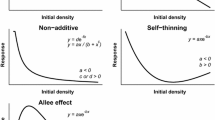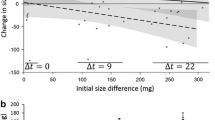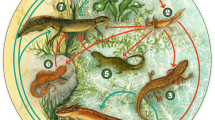Abstract
Mediterranean streams undergo seasonal reductions in water availability that may affect amphibian demography due to habitat loss and the concentration of individuals in the shrinking aquatic habitats. However, there are few empirical examples of how increased population density experienced by larval stages produces long-term effects on growth and fitness at postmetamorphic stages. We tested the effect of four different larval densities on the demography and growth of the endangered stream-dwelling newt Euproctus platycephalus. By manipulating larval populations in experimental aquaria, we analyzed the short-term effects of density in terms of growth and mortality rates as well as of social behavior. To assess medium- and long-term effects we tested the metamorph individuals after 1 and 3 years, respectively, and adults for maternal effect by assessing the relationship between mean larval size and fecundity. Larval body size and growth rate appeared inversely proportional to larval density. Density affected the incidence of aggressive behavior by increasing the rate of mutilation to arms and tail. One-year-old salamanders raised at the highest larval density grew significantly less. All 3-year-old individuals reached comparable body size and body condition irrespective of initial larval density. Salamanders presented a positive relationship between maternal size and (1) fecundity and (2) larval size. In natural conditions, increased density may cause slower growth and a reduction in the percentage of individuals reaching metamorphosis. Prolonged dry periods and increased water withdrawals for agricultural and industrial practices have almost certainly affected the population dynamics of Sardinian newt populations in the long term.





Similar content being viewed by others
References
Akaike H (1974) A new look at the statistical model identification. IEEE Trans Automat Control 19:716–723
Alcher M (1981) Reproduction en élevage de Euproctus platycephalus (Urodela, Salamandradae). Amphibian-Reptilia 2:97–105
Andreone F, Luiselli L (2000) The Italian batrachofauna and its conservation status: a statistical assessment. Biol Conserv 96:197–208
Bodini A, Cossu QA (2010) Vulnerability assessment of Central-East Sardinia (Italy) to extreme rainfall events. Nat Hazard Earth Syst Sci 10:61–72
Capone TA, Kushlan JA (1991) Fish community structure in dryseason stream pools. Ecology 72:983–992
Carey C, Alexander MA (2003) Climate change and amphibian declines: is there a link? Divers Distrib 9:111–121
Casula P, Vignoli L, Luiselli L, Lecis R (2017) Local abundance and observer’s identity affect visual detectability of Sardinian mountain newts. Herpetol J 27:258–265
Crespi EJ, Lessig H (2004) Mothers influence offspring body size through postoviposition maternal effects in the redbacked salamander, Plethodon cinereus. Oecologia 138:306–311
Davenport JM, Summers K (2010) Environmental influences on egg and clutch sizes in lentic and lotic breeding salamanders. Phyllomedusa 9:87–98
Duellman WE (1999) Patterns of distribution of amphibians: a global perspective. Johns Hopkins University Press, Baltimore
Gasith A, Resh VH (1999) Streams in Mediterranean climate regions: abiotic influences and biotic responses to predictable seasonal events. An Rev Ecol Syst 30:51–81
Green AJ (2001) Mass/length residuals: measures of body condition or generators of spurious results? Ecology 82:1473–1483
Jakob EM, Marshall SD, Uetz GW (1996) Estimating fitness: a comparison of body condition indices. Oikos 77:61–67
Kutka FJ, Bachmann MD (1990) Acid sensitivity and water chemistry correlates of amphibian breeding ponds in northern Wisconsin, USA. Hydrobiologia 208:153–160
Lake PS (2003) Ecological effects of perturbation by drought in flowing waters. Freshw Biol 48:1161–1172
Lecis R (2004) The endemic Sardinian newt Euproctus platicephalus: local threats and population decline. It J Zool 2:195–198
Loman J (2004) Density regulation in tadpoles of Rana temporaria: a full pond field experiment. Ecology 85:1611–1618
Loman J, Lardner B (2009) Density dependent growth in adult brown frogs Rana arvalis and Rana temporaria—a field experiment. Acta Oecol 35:824–830
Magoulick DD (2000) Spatial and temporal variation in fish assemblages of drying stream pools: the role of abiotic and biotic factors. Aquat Ecol 34:29–41
Michimae H (2007) Differentiated egg size of the cannibalistic salamander, Hynobius retardatus. J Ethol 25:153–158. https://doi.org/10.1007/s10164-006-0009-9
Pearman PB (1995) Effects of pond size and consequent predator density on two species of tadpoles. Oecologia 102:1–8
Petranka JW (1989) Density-dependent growth and survival of larval Ambystoma: evidence from whole pod manipulations. Ecology 70:1752–1767
Petranka JW, Sih A (1986) Environmental instability, competition, and density-dependent growth and survivorship of a stream-dwelling salamander. Ecology 67:729–736
Romano A, Sindaco R, Andreone F, Lecis R, Edgar P, Schmidt B, Corti C (2009) Euproctus platycephalus. The international union for conservation of nature, red list of threatened species 2009: e.T8371A12907837. http://doi.org/10.2305/IUCN.UK.2009.RLTS.T8371A12907837.en. Accessed Mar 2018
Rovelli V, Randi E, Davoli F, Macale D, Bologna MA, Vignoli L (2015) She gets many and she chooses the best: polygynandry in Salamandrina perspicillata (Amphibia: Salamandridae). Biol J Linn Soc 116:671–683. https://doi.org/10.1111/bij.12613
Rowe CL, Dunson WA (1995) Impacts of hydroperiod on growth and survival of larval amphibians in temporary ponds of Central Pennsylvania, USA. Oecologia 102:397–403
Scott DE (1994) The effect of larval density on adult demographic traits in Ambystoma opacum. Ecology 75:1383–1396
Semlitsch RD (1987) Density-dependent growth and fecundity in the paedomorphic salamander (Ambystoma talpoideum). Ecology 68:1003–1008
Semlitsch RD, Gibbons JW (1990) Effects of egg size on success of larval salamanders in complex aquatic environments. Ecology 71:1789–1795
Stewart MM (1995) Climate driven population fluctuations in rain-forest frogs. J Herpetol 29:437–446
Vignoli L, Macale D, Luiselli L, Lecis R, Casula P (2016) Are conservation assessments of threatened species reliable? Updated distribution of the Endangered Euproctus platycephalus and implications for redlisting Italian amphibians. Oryx 51:482–488
Wells KD (2007) The ecology and behavior of amphibians. University of Chicago Press, Chicago
Wilbur HM (1987) Regulation of structure in complex systems: experimental temporary pond communities. Ecology 68:1437–1452
Acknowledgements
The capture and experimental treatments of newts were authorized by the Italian Ministry of Environment (Protocol number 0022253—20/03/2013—PNM-II). Part of the field collection of newts was funded by EAZA. Two anonymous referees considerably improved a previous draft. LV was gratefully inspired by Roger AO epic win in 2018.
Author information
Authors and Affiliations
Contributions
LV and DM conceived and designed the experiments. DM, CV and FV performed the experiments. LV analyzed the data. LV and LL wrote the manuscript; other authors provided editorial advice.
Corresponding author
Electronic supplementary material
Below is the link to the electronic supplementary material.
About this article
Cite this article
Vignoli, L., Velletrani, F., Venditti, C. et al. Short, medium and long-term effects of density on the demographic traits of a threatened newt. Ecol Res 33, 1039–1048 (2018). https://doi.org/10.1007/s11284-018-1617-x
Received:
Accepted:
Published:
Issue Date:
DOI: https://doi.org/10.1007/s11284-018-1617-x




